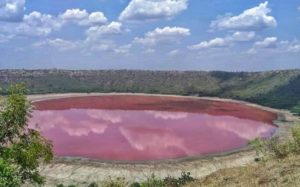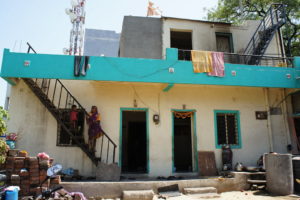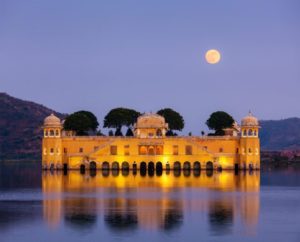10 mysterious places to visit in India

Rosary Church, also known as The Drowning Church, submerges every year during the monsoons and resurfaces as the water levels recede
From worshipping snakes and rats to gravity-defying hills and structures, India is a land full of mysteries. A few places that appear to be straight out of a fantasy novel, there is no dearth of mysterious places to explore here!
‘It happens only in India!’ We’ve often heard people saying that India is a land of mysteries and wondered where the notion came from. India truly has millions of secrets buried deep in its ancient architectures, dense forests and many more places, that either leave people wide-eyed with shock or evokes more curiosity to learn about them.
From hills that pull cars up to stones that float on water, India is home to the most unusual of places. Listed below are 10 mysterious places in the country that are worth a look.
The Hanging Pillar, Lepakshi, Andhra Pradesh

Among the 70 pillars at Lepakshi temple, one hangs in mid-air, without anything visible to hold it up
An important archaeological and historical site in India, Lepakshi is a small village in Andhra Pradesh is known for its architecture and painting. A temple in Lepakshi dedicated to Lord Shiva is among the most mysterious places in India, owing to its famous floating pillar.
Among the 70 pillars at the site, one hangs in mid-air, without anything visible to hold it up. Believers visiting the temple try to pass various objects under the pillar, believing it’ll bring prosperity! Though there are numerous theories behind how it happens, best is to visit the site and see for yourself.
Levitating Rock, Khed Shivapur, Maharashtra
The Hazrat Qamar Ali Darvesh shrine in Khed Shivapur, a village about 25 km south of Pune is unlike any other. It is known for one special rock, kept in its outer courtyard that weighs 70 kg and can only be lifted by a certain number of people with a very specific procedure.
To lift the rock, 11 people are required to gather around it, touch it with their forefingers and loudly chant the name of the saint who placed a curse on it, following which the stone rises up in the air magically! Nobody has ever been able to move the rock by any other means, locals say.
Houses without doors, Shani Shingnapur, Maharashtra
Shani Shingnapur, a small village located 35 km away from Ahmednagar in Maharashtra, is famous for its Shani temple. But that’s not all that is famous about this village. It’s one of the most mysterious places to visit in India citing religious reasons.
None of the houses, schools, shops or even commercial places in this village has a door or even a door frame. In addition to this, not a single crime has ever been reported here. The villagers have undying faith in Lord Shani and believe that the zero crime rate in the village is all because of Lord protecting them. The latest addition to this village is a door-less UCO bank that opened about a year ago!
The Magnetic Hill, Leh, Ladakh
The enchanting hills of Ladakh have more than mere beauty to offer. The Magnetic Hill, located at an altitude of 11,000 feet above sea level is one of the most unusual places to visit in India.
Cars and other vehicles get pulled uphill on their own without being driven by a person for about a kilometre. One can even drive up here with the ignition of their vehicles turned off! This exciting phenomenon is explained to be an optical illusion resulting from the hill’s strong gravitational pull.
The floating stones, Rameshwaram, Tamil Nadu

Tourists often buy a piece or two of similar floating stones as souvenirs which are believed to have been extracted from the original bridge
Rameshwaram in Tamil Nadu holds immense importance in the Hindu mythology, as it is the place where, according to Ramayana, Lord Rama’s Vanara Sena (an army of apes) built a bridge of floating stones all the way to present-day Sri Lanka. But there is something else about the bridge that makes this place one of the most mysterious places in India.
According to Ramayana, the bridge was built of stones that would stay afloat once the name of Lord Rama was scribbled on it. A few stones from the floating bridge, as devotees believe, are still found around here and are a major tourist attraction in Rameshwaram. Tourists often buy a piece or two of similar floating stones as souvenirs which are believed to have been extracted from the original bridge.
The drowning Church, Shettihalli, Karnataka
Built by French missionaries in the 1860s, the Rosary Church, as it was called back then, was a centre of all community activities for a century in the small town about 220 km north-west of Bengaluru. The building not only included a church and an orphanage, but also a hospital.
However, exactly 100 years later, Gorur Dam was built here, flooding the Hemavathi Reservoir. This forced people to leave their homes and they had little choice than to abandon the Rosary Church.
Since its first flooding, Rosary Church submerges every year during the monsoons and resurfaces as the water levels recede. Battling the regular tests, Rosary Church now has a mysterious charm to it and a new name – The Drowning Church.
The musical pillars, Hampi, Karnataka
Originally built in the 15th century, Vittalatemple is one of the most extravagant pieces of architecture in Hampi. However, what sets it apart from some other equally glorious temples around the country is a collection of 56 musical pillars, which produce musical notes when tapped gently. During their rule, the British were so intrigued by the pillars’ music producing ability that they cut two pillars into half to check if anything was inside the seemingly hollow pillars of granite. If you are interested, you can still check these two broken pillars inside the temple complex.
Over the years, curious visitors damaged several other musical pillars by regularly tapping them. To protect any further damage to this heritage site, tapping on musical pillars is now forbidden.
Crater Lake, Lonar, Maharashtra

the unique chemical composition of water supports several microorganisms that are rarely found elsewhere
Lonar, a village around 140 km from Aurangabad, is home to a highly remarkable meteor impact crater. Recognised as the only hyper-velocity impact crater in basaltic rock in the world, it has a lake inside it that is alkaline and saline at the same time.
To add to the science fiction elements, no one knows the source of the perennial springs that feed the lake and what lurks at its murky bottom. Moreover, compasses don’t work in many parts of the lake and somehow the unique chemical composition of its water supports several microorganisms that are rarely found elsewhere on the planet.
Jal Mahal, Jaipur, Rajasthan
Located right in the middle of Man Sagar Lake, Jal Mahal in Jaipur has been abandoned for ages now. It is said to have been built as a summer retreat for the Royals.
However, today, it lies abandoned and desolate, in the centre of the lake. This is a mysterious and unusual place in India as it actually has five storeys, with four of them being submerged in the lake! How the palace came to be submerged, no one knows. However, it makes for a hauntingly beautiful experience. You can book a boat and view the submerged palace up close, in peace.
The great Banyan tree, Howrah, West Bengal
What looks like a dense forest from afar, is actually just one wildly growing tree! About 3,600 aerial roots of this 342-year-old banyan tree have spread across a vast space, making it look just like a forest. With a circumference of 1.08 km, this tree is the widest tree in the world! To facilitate visitors, there is a road that goes all around the tree.















